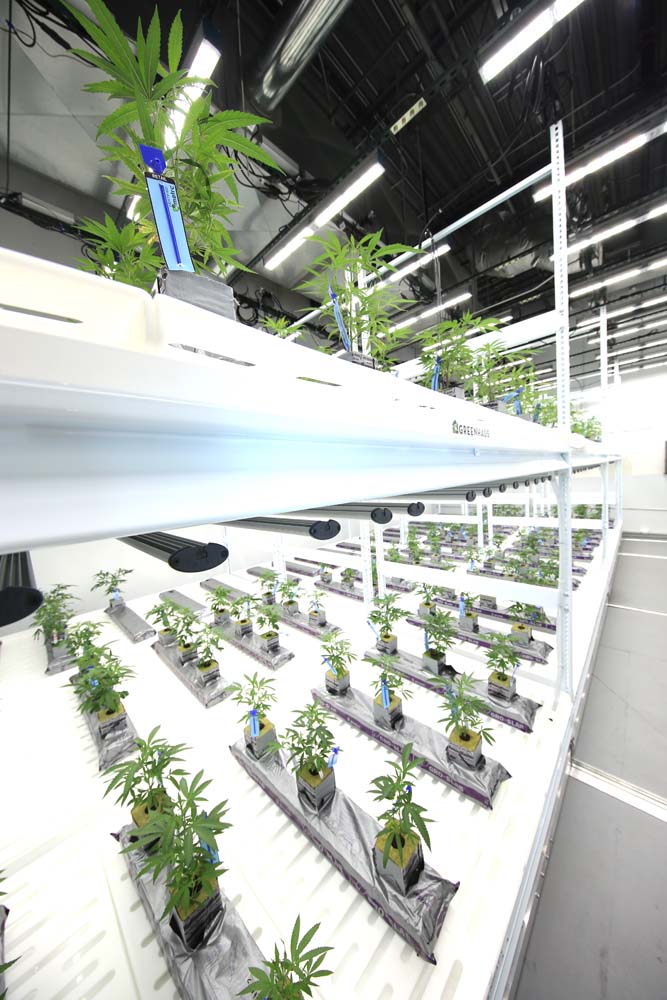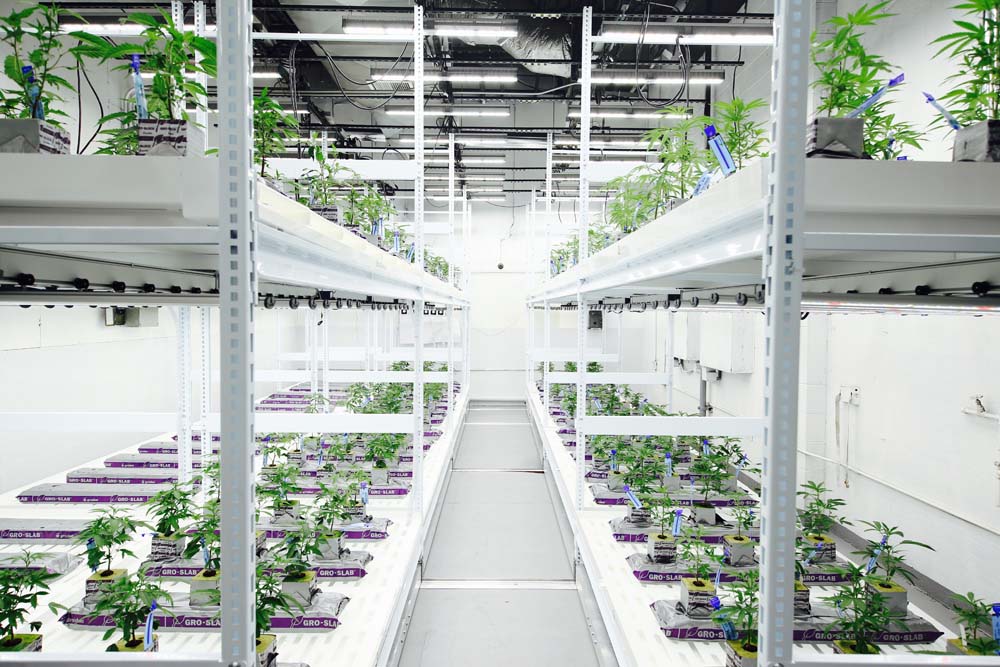As the cannabis industry matures, cannabis growers must stay informed on new vertical farming technology and improved cultivation practices. Here at Pipp Horticulture, we are continuously developing and optimizing vertical farming systems for cannabis and other high-value crops. These cultivation systems and methods will take your operation to another level, literally, by utilizing the vertical dimension (height) to maximize your production capacity.
Vertical growing can significantly increase your facility’s output by improving on antiquated single-level and static canopy layouts by utilizing the unused horizontal and vertical space above and between your canopy to increase your production capabilities. Vertical growing methods have taken a foothold in an industry that is scaling and becoming more efficient. Whether you’re new to vertical growing or need a refresher, in this article, we will examine the following and much more:
● What is vertical growing, and what are its advantages
● How vertical growing can improve growing capacity, efficiency, and ROI
● What equipment is needed to set up a vertical growing operation
● A case study about how Leafline Labs reclaimed wasted grow space
Vertical Growing Vs. Other Methods
For something that can have such an exponential impact on your operation, vertical growing is pretty straightforward. It involves using the previously unused space above and between your plants to increase your total yield capacity. Constructing additional layers of cultivation space above your typical single-level operation allows more cannabis to grow in the same square footage. Similar to the way an apartment building stacks identical levels atop the lobby, allowing more people to live.
While there is often some additional planning and capital expenditures upfront, vertical growing is an exponential boost to your growing capacity without the need to acquire or build additional cultivation space. Vertical growing offers clear advantages over other cultivation methods including:
● Outdoor: While a classic cannabis cultivation method, setting up your grow operation outdoors means sacrificing control over your environment, and dealing with the inevitable invasion of pests, and unpredictable weather.
● Greenhouse: Greenhouse growing helps combat some of the problems of outdoor growing but can be costly and restrictive in maximizing space when designed to accommodate single-level growing benches.
● Single Level Indoor: Improved environmental control, reduced issues with the ambient environment, and consistent lighting, indoor growing is the cannabis growing method of choice for many commercial cultivators. However, like greenhouse growing, single-level indoor growing creates production limitations. Whereas vertical growing stacks plants in the same space to double, triple (or more!) your total plant capacity and increase your yields accordingly.
Top 7 Advantages of Vertical Cannabis Growing
No matter what form of vertical cannabis growing you choose, vertical farming offers a wide range of advantages. The use of vertical space and accompanying concentration of plants offers efficiencies of both scale and workflow to help you get the most out of your cannabis grow operation. These include:
● Maximization of production capacity within a fixed space.
● Increased horizontal canopy space by the elimination of stationery aisles, by creating a more dynamic grow space.
● More efficient use of utilities, through LED lighting, and closed-loop irrigation systems that capture and reuse water.
● Providing a consistent cultivation platform for multi-state operations (MSOs) to standardize, streamline, and expand outputs within and beyond the current cultivation footprint.
● Reducing the necessity of relocating or acquiring additional production capacity as demand grows, by optimizing the total production capabilities of your existing space.
● Improved employee safety and ergonomics by utilizing platforms and lifts that adjust to optimal work height.
● Ability to increase production with limited downtime. Eliminate construction, permitting, and buildout by creating a production phasing plan that incorporates Pipp Racking that can expand quickly by simply adding additional levels as additional production is required.


Why Choose A Vertical Grow System
The primary way that vertical grow systems boost your production capacity is by designing your grow space in a way that maximizes the cubic cultivation capacity while providing a consistent optimal environment for your plants.
In this highly competitive industry where margins are continually tightening, every detail, or every cubic foot or meter matters to produce higher-quality cannabis for less. A huge component of this is designing the grow space to be as effective and efficient as possible. If you’re interested in learning more about cultivation facility design, you can check out this in-depth video with tips from industry experts!
One of the unique aspects of vertical growing is that your operation’s design shapes your growing process, workflow, and vice versa. By combining the advantages of vertical growing with the design and process thinking outlined above, you can address limitations and expansion goals.
How Vertical Cannabis Farming Can Improve Efficiency & ROI
Along with the production capacity advantages vertical cannabis farming provides, it also helps reduce costs and leads to a more efficient operation.
Beyond optimizing your grow space in the ways we’ve discussed above, which will lower your overall COGS, vertical cannabis growing reduces your canopy costs in the long term too. Perhaps the most significant investment for an expanding cannabis company is purchasing or building a new cultivation space or adding on to an existing facility to accommodate increasing demand.
Vertical growing disrupts this potential endeavor. The thought of building out multiple levels of lights and racks in all your rooms might make your head spin. However, through a phased approach, you can begin to install racks and infrastructure to the first level and go vertical as demand, time, and investment permit.
In this way, growing capacity is easily increased without permitting, construction, or significant downtime, giving your operation greater flexibility and a higher ROI.
The Future of Growing is Vertical
Another reason to pursue vertical growing in your cannabis operation is because of several looming issues with traditional farming and agriculture that will affect the cannabis industry.
First off, land constraints and population increase will drive the need to rethink how we farm, and lead many cultivators to pursue more economical urban grow operations. In the near future, indoor vertical farming will likely enable you to buy tropical fruit from within 100 miles of where you live, and the same goes for cannabis. A move towards indoor, vertical farming will reduce the strain that our current agricultural and cannabis industry puts on the environment.
Another relevant movement is the imposition of LED light regulations on indoor cultivators. Motivated by LED bulbs’ superior energy efficiency over other less efficient bulbs, states like California are proposing legislation that will require all indoor cultivators to use only LED lights by 2023. This would cost millions to most growers, leading to significant advantages for those that have already or currently implementing vertical grow systems throughout their cultivation facilities. Vertical farming is a solution to the impending agricultural constraints, both physical and governmental. It’s time to explore and benefit from the possibilities.
Understanding Essential Vertical Growing Equipment
To benefit from all of the advantages of vertical growing we’ve outlined so far requires an understanding of what equipment you need, and why. While rethinking your grow operation can reap huge rewards, it can also backfire if you don’t put in the proper forethought into your facility design and cannabis production plan.
There are many different aspects to consider when choosing your vertical grow equipment, including:
● How the grow racks fit in your grow facility, to maximize utilization of the space, accommodate the necessary working space around the racks, and ensure perpetual production with limited downtime.
● Proper light spacing and distance from canopy, to maximize the effectiveness of lighting coverage.
● Your HVAC and airflow needs, to keep fresh, clean air in your grow space
● An understanding of microclimates within your grow space, so you can better control them.
● Shelf strength and capacity to provide all your plants a safe and sturdy home
● Proper surface material and sanitization routines, to prevent contaminants.
● Safe and ergonomic approach to plant maintenance across all levels and grow phases.
A Case Study: Leafline Labs
Leafline Labs is one of our customers who we helped to capitalize on wasted vertical space. They were forecasting an increase in demand for their high-quality medical cannabis but worried about the significant vertical space they were wasting.
Leafline also wanted to increase its current facility’s cultivation capacity, through mobile, multi-level vertical growing systems. This meant we had to consider the impact on current production and harvest cycles, with thoughtful planning to minimize disruption.
We helped them convert from a traditional HPS, single-level canopy design to a mobile multi-level LED setup. We installed our double tier, high-density vertical grow rack system, and our patent-pending Drip-to-Drain Trays and HDPE Inserts.
We worked closely with LeafLine Labs’ construction and electrician teams to ensure a smooth, speedy, and successful installation. The implementation of our mobile cultivation systems resulted in an impressive 140% increase in canopy space, a decrease in radiant heat, minimized evaporation, and a reduction in the amount of water required for growing.


Add a Comment